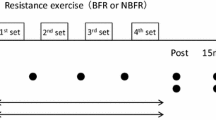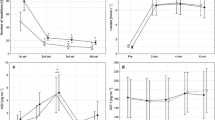Abstract
Purpose
The aim of the study is to examine the relationships between increments in resting blood flow and isometric maximal voluntary contraction (MVC) force reduction, muscle soreness, and swelling after eccentric contractions (ECs).
Methods
Twenty-one young healthy men (age 20.8 ± 1.6 years; height 172.0 ± 5.3 cm; weight 64.9 ± 7.7 kg) were recruited for this study. All participants performed right arm ECs in five sets of 20 repetitions with 3 min of rest between the sets. The dumbbell weight corresponded to 60% MVC force of isometric contraction of elbow flexors with 90° elbow joint angle. Resting forearm blood flow (FBF), the MVC force, the muscle thickness (MT), and muscle soreness of elbow flexors, heart rate (HR), and blood pressure (BP) of brachial artery were measured before, 24 and 48 h after ECs.
Results
Average and peak resting FBF after ECs significantly changed from the average values before ECs (21% and 39% increase, respectively, P < 0.01). However, resting HR and BP were not significantly different after ECs. Average increase in resting FBF showed a significant relationship with average isometric MVC force reduction (r = − 0.45, P < 0.05), peak isometric MVC force reduction (r = − 0.48, P < 0.05), average muscle soreness (r = 0.49, P < 0.05), and peak muscle soreness (r = 0.49, P < 0.05). Moreover, stepwise multiple regression analysis revealed that average increased resting FBF was explained by isometric MVC force reduction and muscle soreness (adjusted R2 = 0.33).
Conclusions
These results suggested that increments in resting blood flow reflect muscle damage, and increased resting blood flow may be a result of acute inflammatory response induced by muscle damage.



Similar content being viewed by others
Abbreviations
- ANOVA:
-
Analysis of variance
- BP:
-
Blood pressure
- ECs:
-
Eccentric contractions
- EIMD:
-
Exercise-induced muscle damage
- FBF:
-
Forearm blood flow
- DOMS:
-
Delayed-onset muscle soreness
- HR:
-
Heart rate
- IMP:
-
Intramuscular pressure
- MT:
-
Muscle thickness
- MVC:
-
Maximal voluntary contraction
- VAS:
-
Visual analog scale
References
Ahmadi S, Sinclair PJ, Foroughi N, Davis GM (2008) Monitoring muscle oxygenation after eccentric exercise-induced muscle damage using near-infrared spectroscopy. Appl Physiol Nutr Metab 33:743–752
Blais C Jr, Adam A, Massicotte D, Péronnet F (1999) Increase in blood bradykinin concentration after eccentric weight-training exercise in men. J Appl Physiol (1985) 87:1197–1201
Caldwell JT, Wardlow GC, Branch PA, Ramos M, Black CD, Ade CJ (2016) Effect of exercise-induced muscle damage on vascular function and skeletal muscle microvascular deoxygenation. Physiol Rep 4:e13032
Chapman D, Newton M, Sacco P, Nosaka K (2006) Greater muscle damage induced by fast versus slow velocity eccentric exercise. Int J Sports Med 27:591–598
Chapman DW, Newton M, McGuigan MR, Nosaka K (2008) Comparison between old and young men for responses to fast velocity maximal lengthening contractions of the elbow flexors. Eur J Appl Physiol 104:531–539
Chen TC, Lin KY, Chen HL, Lin MJ, Nosaka K (2011) Comparison in eccentric exercise-induced muscle damage among four limb muscles. Eur J Appl Physiol 111:211–223
Chen TC, Chen HL, Pearce AJ, Nosaka K (2012) Attenuation of eccentric exercise-induced muscle damage by preconditioning exercises. Med Sci Sports Exerc 44:2090–2098
Choi Y, Akazawa N, Zempo-Miyaki A, Ra SG, Shiraki H, Ajisaka R, Maeda S (2016) Acute effect of high-intensity eccentric exercise on vascular endothelial function in young men. J Strength Cond Res 30:2279–2285
Clarkson PM, Hubal MJ (2002) Exercise-induced muscle damage in humans. Am J Phys Med Rehabil 81:S52–S69
Clarkson PM, Byrnes WC, McCormick KM, Turcotte LP, White JS (1986) Muscle soreness and serum creatine kinase activity following isometric, eccentric, and concentric exercise. Int J Sports Med 7:152–155
Clarkson PM, Nosaka K, Braun B (1992) Muscle function after exercise-induced muscle damage and rapid adaptation. Med Sci Sports Exerc 24:512–520
Crenshaw AG, Thornell LE, Fridén J (1994) Intramuscular pressure, torque and swelling for the exercise-induced sore vastus lateralis muscle. Acta Physiol Scand 152:265–277
Damas F, Nosaka K, Libardi CA, Chen TC, Ugrinowitsch C (2016) Susceptibility to exercise-induced muscle damage: a cluster analysis with a large sample. Int J Sports Med 37:633–640
Feliciani G, Peron C, La Rocca A, Scuppa MF, Malavolta A, Bianchini D, Corazza I, Zannoli R (2016) Cold pressor test using strain-gauge plethysmography. Adv Physiol Educ 40:410–417
Fujii Y, Ozaki N, Taguchi T, Mizumura K, Furukawa K, Sugiura Y (2008) TRP channels and ASICs mediate mechanical hyperalgesia in models of inflammatory muscle pain and delayed onset muscle soreness. Pain 140:292–304
Gibson W, Arendt-Nielsen L, Taguchi T, Mizumura K, Graven-Nielsen T (2009) Increased pain from muscle fascia following eccentric exercise: animal and human findings. Exp Brain Res 194:299–308
Hasenoehrl T, Wessner B, Tschan H, Vidotto C, Crevenna R, Csapo R (2017) Eccentric resistance training intensity may affect the severity of exercise induced muscle damage. J Sports Med Phys Fitness 57:1195–1204
Hody S, Croisier JL, Bury T, Rogister B, Leprince P (2019) Eccentric muscle contractions: risks and benefits. Front Physiol 10:536
Hotta K, Behnke BJ, Masamoto K, Shimotsu R, Onodera N, Yamaguchi A, Poole DC, Kano Y (2018) Microvascular permeability of skeletal muscle after eccentric contraction-induced muscle injury: in vivo imaging using two-photon laser scanning microscopy. J Appl Physiol (1985) 125:369–380
Hyldahl RD, Xin L, Hubal MJ, Moeckel-Cole S, Chipkin S, Clarkson PM (2011) Activation of nuclear factor-κB following muscle eccentric contractions in humans is localized primarily to skeletal muscle-residing pericytes. FASEB J 25:2956–2966
Kellermann M, Heiss R, Swoboda B, Gelse K, Freiwald J, Grim C, Nagel A, Uder M, Wildner D, Hotfiel T (2017) Intramuscular perfusion response in delayed onset muscle soreness (DOMS): a quantitative analysis with contrast-enhanced ultrasound (CEUS). Int J Sports Med 38:833–841
Laaksonen MS, Kivelä R, Kyröläinen H, Sipilä S, Selänne H, Lautamäki R, Nuutila P, Knuuti J, Kalliokoski KK, Komi PV (2006) Effects of exhaustive stretch-shortening cycle exercise on muscle blood flow during exercise. Acta Physiol (Oxf) 186:261–270
Lau WY, Blazevich AJ, Newton MJ, Wu SS, Nosaka K (2015) Changes in electrical pain threshold of fascia and muscle after initial and secondary bouts of elbow flexor eccentric exercise. Eur J Appl Physiol 115:959–968
Lavender AP, Nosaka K (2006) Changes in fluctuation of isometric force following eccentric and concentric exercise of the elbow flexors. Eur J Appl Physiol 96:235–240
Lee A, Baxter J, Eischer C, Gage M, Hunter S, Yoon T (2017) Sex differences in neuromuscular function after repeated eccentric contractions of the knee extensor muscles. Eur J Appl Physiol 117:1119–1130
Maeo S, Yamamoto M, Kanehisa H, Nosaka K (2017) Prevention of downhill walking-induced muscle damage by non-damaging downhill walking. PLoS ONE 12:e0173909
Magder S (2018) The meaning of blood pressure. Crit Care 22:257
Meneghel AJ, Verlengia R, Crisp AH, Aoki MS, Nosaka K, da Mota GR, Lopes CR (2014) Muscle damage of resistance-trained men after two bouts of eccentric bench press exercise. J Strength Cond Res 28:2961–2966
Molloy CB, Al-Omar AO, Edge KT, Cooper RG (2006) Voluntary activation failure is detectable in some myositis patients with persisting quadriceps femoris weakness: an observational study. Arthritis Res Ther 8:R67
Nosaka K, Clarkson PM (1996) Changes in indicators of inflammation after eccentric exercise of the elbow flexors. Med Sci Sports Exerc 28:953–961
Nosaka K, Newton M (2002) Difference in the magnitude of muscle damage between maximal and submaximal eccentric loading. J Strength Cond Res 16:202–208
Nosaka K, Sakamoto K (2001) Effect of elbow joint angle on the magnitude of muscle damage to the elbow flexors. Med Sci Sports Exerc 33:22–29
Nosaka K, Newton M, Sacco P (2002) Delayed-onset muscle soreness does not reflect the magnitude of eccentric exercise-induced muscle damage. Scand J Med Sci Sports 12:337–346
Ohnhaus EE, Adler R (1975) Methodological problems in the measurement of pain: a comparison between the verbal rating scale and the visual analogue scale. Pain 1:379–384
Paulsen G, Crameri R, Benestad HB, Fjeld JG, Mørkrid L, Hallén J, Raastad T (2010) Time course of leukocyte accumulation in human muscle after eccentric exercise. Med Sci Sports Exerc 42:75–85
Peake J, Nosaka K, Suzuki K (2005) Characterization of inflammatory responses to eccentric exercise in humans. Exerc Immunol Rev 11:64–85
Peake J, Neubauer O, Della Gatta PA, Nosaka K (2017) Muscle damage and inflammation during recovery from exercise. J Appl Physiol (1985) 122:559–570
Petrie JR, Ueda S, Morris AD, Murray LS, Elliott HL, Connell JM (1998) How reproducible is bilateral forearm plethysmography? Br J Clin Pharmacol 45:131–139
Radaelli R, Bottaro M, Wilhelm EN, Wagner DR, Pinto RS (2012) Time course of strength and echo intensity recovery after resistance exercise in women. J Strength Cond Res 26:2577–2584
Roberts DH, Tsao Y, Breckenridge AM (1986) The reproducibility of limb blood flow measurements in human volunteers at rest and after exercise by using mercury-in-Silastic strain gauge plethysmography under standardized conditions. Clin Sci (Lond) 70:635–638
Sayers SP, Clarkson PM (2001) Force recovery after eccentric exercise in males and females. Eur J Appl Physiol 84:122–126
Sbriccoli P, Felici F, Rosponi A, Aliotta A, Castellano V, Mazzà C, Bernardi M, Marchetti M (2001) Exercise induced muscle damage and recovery assessed by means of linear and non-linear sEMG analysis and ultrasonography. J Electromyogr Kinesiol 11:73–83
Selkow NM, Herman DC, Liu Z, Hertel J, Hart JM, Saliba SA (2015) Blood flow after exercise-induced muscle damage. J Athl Train 50:400–406
Souza-Silva E, Christensen SW, Hirata RP, Larsen RG, Graven-Nielsen T (2018) Blood flow after contraction and cuff occlusion is reduced in subjects with muscle soreness after eccentric exercise. Scand J Med Sci Sports 28:29–39
Stacy MR, Bladon KJ, Lawrence JL, McGlinchy SA, Scheuermann BW (2013) Serial assessment of local peripheral vascular function after eccentric exercise. Appl Physiol Nutr Metab 38:1181–1186
Taguchi T, Matsuda T, Tamura R, Sato J, Mizumura K (2005) Muscular mechanical hyperalgesia revealed by behavioural pain test and c-Fos expression in the spinal dorsal horn after eccentric contraction in rats. J Physiol 564:259–268
Takahashi H, Kuno S, Miyamoto T, Yoshioka H, Inaki M, Akima H, Katsuta S, Anno I, Itai Y (1994) Changes in magnetic resonance images in human skeletal muscle after eccentric exercise. Eur J Appl Physiol Occup Physiol 69:408–413
Talag TS (1973) Residual muscular soreness as influenced by concentric, eccentric, and static contractions. Res Q 44:458–469
Warren GL, Ingalls CP, Lowe DA, Armstrong RB (2001) Excitation–contraction uncoupling: major role in contraction-induced muscle injury. Exerc Sport Sci Rev 29:82–87
Warren GL, Ingalls CP, Lowe DA, Armstrong RB (2002) What mechanisms contribute to the strength loss that occurs during and in the recovery from skeletal muscle injury? J Orthop Sports Phys Ther 32:58–64
Xin L, Hyldahl RD, Chipkin SR, Clarkson PM (2014) A contralateral repeated bout effect attenuates induction of NF-κB DNA binding following eccentric exercise. J Appl Physiol 116:1473–1480
Acknowledgements
This work was supported in part by JSPS KAKENHI (Grant No. 18J12681). We are grateful to Professor Keisho Katayama, PhD of Nagoya University for excellent advice. We thank Hugh McGonigle, from Edanz Group (www.edanzediting.com/ac), for editing a draft of the manuscript.
Author information
Authors and Affiliations
Contributions
All authors participated in conducting experiments. HM and MS carried out measurements. HM, MS, KI, and HA analyzed data and drafted the manuscript. All authors approved the final manuscript.
Corresponding author
Ethics declarations
Conflict of interest
The author(s) declare that they have no conflict of interest.
Ethical approval
This study was approved by the ethics committees of the Research Center of Health, Physical Fitness, and Sports at Nagoya University (30-06), and proceeded in accordance with the guidelines of the Declaration of Helsinki.
Additional information
Communicated by Massimo Pagani.
Publisher's Note
Springer Nature remains neutral with regard to jurisdictional claims in published maps and institutional affiliations.
Rights and permissions
About this article
Cite this article
Maeda, H., Saito, M., Ishida, K. et al. Relationships between resting blood flow and the indices of muscle damage after eccentric contractions. Eur J Appl Physiol 120, 2183–2192 (2020). https://doi.org/10.1007/s00421-020-04442-1
Received:
Accepted:
Published:
Issue Date:
DOI: https://doi.org/10.1007/s00421-020-04442-1




